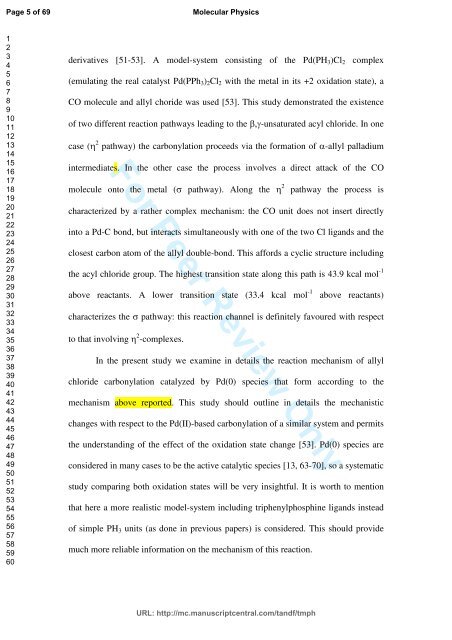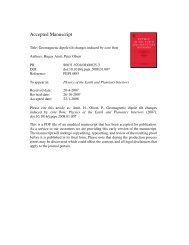For Peer Review Only - TARA
For Peer Review Only - TARA
For Peer Review Only - TARA
You also want an ePaper? Increase the reach of your titles
YUMPU automatically turns print PDFs into web optimized ePapers that Google loves.
Page 5 of 69<br />
Molecular Physics<br />
1<br />
2<br />
3<br />
4<br />
5<br />
6<br />
7<br />
8<br />
9<br />
10<br />
11<br />
12<br />
13<br />
14<br />
15<br />
16<br />
17<br />
18<br />
19<br />
20<br />
21<br />
22<br />
23<br />
24<br />
25<br />
26<br />
27<br />
28<br />
29<br />
30<br />
31<br />
32<br />
33<br />
34<br />
35<br />
36<br />
37<br />
38<br />
39<br />
40<br />
41<br />
42<br />
43<br />
44<br />
45<br />
46<br />
47<br />
48<br />
49<br />
50<br />
51<br />
52<br />
53<br />
54<br />
55<br />
56<br />
57<br />
58<br />
59<br />
60<br />
derivatives [51-53]. A model-system consisting of the Pd(PH 3 )Cl 2 complex<br />
(emulating the real catalyst Pd(PPh 3 ) 2 Cl 2 with the metal in its +2 oxidation state), a<br />
CO molecule and allyl choride was used [53]. This study demonstrated the existence<br />
of two different reaction pathways leading to the β,γ-unsaturated acyl chloride. In one<br />
case (η 2 pathway) the carbonylation proceeds via the formation of α-allyl palladium<br />
<strong>For</strong> <strong>Peer</strong> <strong>Review</strong> <strong>Only</strong><br />
intermediates. In the other case the process involves a direct attack of the CO<br />
molecule onto the metal (σ pathway). Along the η 2 pathway the process is<br />
characterized by a rather complex mechanism: the CO unit does not insert directly<br />
into a Pd-C bond, but interacts simultaneously with one of the two Cl ligands and the<br />
closest carbon atom of the allyl double-bond. This affords a cyclic structure including<br />
the acyl chloride group. The highest transition state along this path is 43.9 kcal mol -1<br />
above reactants. A lower transition state (33.4 kcal mol -1 above reactants)<br />
characterizes the σ pathway: this reaction channel is definitely favoured with respect<br />
to that involving η 2 -complexes.<br />
In the present study we examine in details the reaction mechanism of allyl<br />
chloride carbonylation catalyzed by Pd(0) species that form according to the<br />
mechanism above reported. This study should outline in details the mechanistic<br />
changes with respect to the Pd(II)-based carbonylation of a similar system and permits<br />
the understanding of the effect of the oxidation state change [53]. Pd(0) species are<br />
considered in many cases to be the active catalytic species [13, 63-70], so a systematic<br />
study comparing both oxidation states will be very insightful. It is worth to mention<br />
that here a more realistic model-system including triphenylphosphine ligands instead<br />
of simple PH 3 units (as done in previous papers) is considered. This should provide<br />
much more reliable information on the mechanism of this reaction.<br />
URL: http://mc.manuscriptcentral.com/tandf/tmph
















